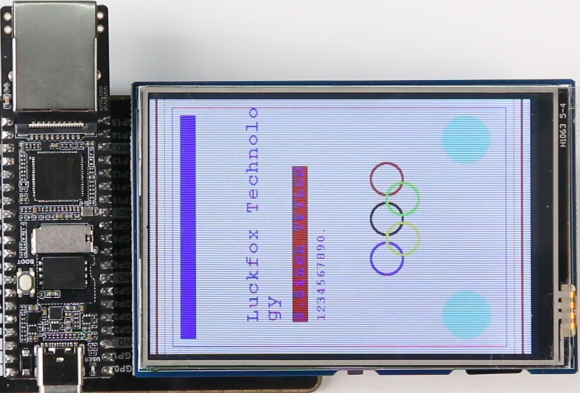ResTouch LCD
This article aims to provide a detailed guide on how to use Luckfox Pico Plus to drive a 3.5-inch screen. We will be using Waveshare's Pico-ResTouch-LCD-3.5 resistive touchscreen expansion board. You can find specific details about the screen in the product wiki for Pico-ResTouch-LCD-3.5. You can download the image file and sample program to use directly or follow the steps below to configure it yourself.
1. Compatible Device Configuration
The Luckfox Pico / Plus / Pro / Max series mainly refers to the pin layout of the Raspberry Pi Pico, and through pin configuration, it can be compatible with some Raspberry Pi Pico peripherals.

For the list of compatible devices supported by different models of Luckfox Pico, refer to Luckfox-Pico_support-List.
The compatible device option is essentially a combination of multiple pin configurations, which can simplify the configuration process.
Due to the lack of io commands to directly configure registers under Ubuntu, the Luckfox Pico cannot configure the pins as default pull-up when configuring the compatible device Pico-LCD, so it cannot properly control the buttons.
When starting the compatible device configuration, it will overwrite the original configuration. To cancel the compatible device, go to the Advanced Options screen to disable the started device function.
2. Example Program
The Pico-ResTouch-LCD-3.5 resistive touch screen expansion board features the XPT2046 resistive touch control chip and a Micro SD card slot, allowing for display, touch, and SD card reading functionalities. To achieve these functions, we need to define pins in the program and implement SPI communication, followed by compiling the program using a cross-compilation tool. Let's delve into the specific implementation steps.
Pin Definitions
Define the pin numbers in
DEV_Config.h#define LCD_DC_PIN (34)
#define LCD_CS_PIN (48) //Define LCD chip select pin number
#define LCD_RST_PIN (57)
#define LCD_BL_PIN (4)
#define TP_CS_PIN (102)
#define TP_IRQ_PIN (103)
#define SD_CS_PIN (97)Add Control Pin Level Macro Definitions in
DEV_Config.h//LCD
#define LCD_CS_0 DEV_Digital_Write(LCD_CS_PIN,0) //LCD chip select pin pulled low
#define LCD_CS_1 DEV_Digital_Write(LCD_CS_PIN,1) //LCD chip select pin set high
#define LCD_RST_0 DEV_Digital_Write(LCD_RST_PIN,0)
#define LCD_RST_1 DEV_Digital_Write(LCD_RST_PIN,1)
#define LCD_DC_0 DEV_Digital_Write(LCD_DC_PIN,0)
#define LCD_DC_1 DEV_Digital_Write(LCD_DC_PIN,1)
#define LCD_BL_0 DEV_Digital_Write(LCD_BL_PIN,0)
#define LCD_BL_1 DEV_Digital_Write(LCD_BL_PIN,1)
//TP
#define TP_CS_0 DEV_Digital_Write(TP_CS_PIN,0)
#define TP_CS_1 DEV_Digital_Write(TP_CS_PIN,1)
//SD
#define SD_CS_0 DEV_Digital_Write(SD_CS_PIN,0)
#define SD_CS_1 DEV_Digital_Write(SD_CS_PIN,1)Initialize GPIO in
DEV_GPIO_InitFunctionstatic void DEV_GPIO_Init(void)
{
DEV_GPIO_Mode(LCD_CS_PIN, 1); //LCD chip select pin initialized as output
DEV_GPIO_Mode(LCD_RST_PIN, 1);
DEV_GPIO_Mode(LCD_DC_PIN, 1);
DEV_GPIO_Mode(LCD_BL_PIN, 1);
DEV_GPIO_Mode(TP_CS_PIN, 1);
DEV_GPIO_Mode(SD_CS_PIN, 1);
DEV_GPIO_Mode(TP_IRQ_PIN, 0);
LCD_CS_1; //LCD chip select pin set high
TP_CS_1;
SD_CS_1;
LCD_BL_0;
}
SPI Communication
Request SPI Resources in the
DEV_ModuleInitFunctionDEV_HARDWARE_SPI_begin("/dev/spidev0.0");Initialization
LCD_SCAN_DIR lcd_scan_dir = SCAN_DIR_DFT; // Choose the rotation angle
SD_Init(); // Initialize Micro SD
LCD_Init(lcd_scan_dir, 800); // Initialize LCD
TP_Init(lcd_scan_dir); // Initialize touch ICThe sample program is also compatible with the Pico-ResTouch-LCD-2.8 resistive touch screen expansion board. In the program, the LCD model is determined by calling the
LCD_Read_Idfunction to read the ID value.static void LCD_InitReg(void)
{
id = LCD_Read_Id();
if(LCD_2_8 == id){
// Initialize for 2.8-inch LCD
}else{
// Initialize for 3.5-inch LCD
}
}In the LCD_Read_Id function, the DEV_HARDWARE_SPI_TransferByte function is called to send and receive data to and from the LCD.
uint8_t LCD_Read_Id(void)
{
uint8_t reg = 0xDC;
uint8_t tx_val = 0x00;
uint8_t rx_val;
DEV_Digital_Write(LCD_CS_PIN, 0); // Initiate communication, pull down LCD_CS_PIN
DEV_Digital_Write(LCD_DC_PIN, 0); // Pull down LCD_DC_PIN to indicate command transmission
DEV_HARDWARE_SPI_TransferByte(reg); // Send command to LCD
rx_val = DEV_HARDWARE_SPI_TransferByte(tx_val); // Send command to LCD and receive the return value
DEV_Digital_Write(LCD_CS_PIN, 1); // End communication, pull up LCD_CS_PIN
return rx_val; // Return the data read
}
Cross Compilation
Specify the Cross Compilation Tool
Users should move the entire "c" folder to the virtual machine and edit the
Makefilefile within the "c" folder. Modify the content after CC= in theMakefileto specify the cross-compilation tool.Replace
<SDK Directory>with your own SDK path in the Makefile, for example,/home/luckfox/luckfox-pico/.DIR_Config = ./lib/Config
DIR_EPD = ./lib/LCD
DIR_FONTS = ./lib/Fonts
DIR_GUI = ./lib/GUI
DIR_Examples = ./examples
DIR_FATFS = ./lib/Fatfs
DIR_SDCARD = ./lib/Sdcard
DIR_BIN = ./bin
OBJ_C = $(wildcard ${DIR_EPD}/*.c ${DIR_Config}/*.c ${DIR_GUI}/*.c ${DIR_Examples}/*.c ${DIR_FONTS}/*.c ${DIR_FATFS}/*.c ${DIR_SDCARD}/*.c)
OBJ_O = $(patsubst %.c,${DIR_BIN}/%.o,$(notdir ${OBJ_C}))
TARGET = main
USELIB = USE_DEV_LIB
DEBUG = -D $(USELIB)
ifeq ($(USELIB), USE_DEV_LIB)
LIB = -lpthread -lm
endif
CC = <SDK Directory>/tools/linux/toolchain/arm-rockchip830-linux-uclibcgnueabihf/bin/arm-rockchip830-linux-uclibcgnueabihf-gcc
MSG = -g -O0 -Wall
CFLAGS += $(MSG) $(DEBUG)
${TARGET}:${OBJ_O}
$(CC) $(CFLAGS) $(OBJ_O) -o $@ $(LIB)
${DIR_BIN}/%.o:$(DIR_Examples)/%.c
$(CC) $(CFLAGS) -c $< -o $@ -I $(DIR_Config) -I $(DIR_GUI) -I $(DIR_EPD)
${DIR_BIN}/%.o:$(DIR_EPD)/%.c
$(CC) $(CFLAGS) -c $< -o $@ -I $(DIR_Config) -I $(DIR_GUI) -I $(DIR_FATFS)
${DIR_BIN}/%.o:$(DIR_FONTS)/%.c
$(CC) $(CFLAGS) -c $< -o $@
${DIR_BIN}/%.o:$(DIR_GUI)/%.c
$(CC) $(CFLAGS) -c $< -o $@ -I $(DIR_Config) -I $(DIR_EPD) -I $(DIR_Examples) -I $(DIR_FONTS)
${DIR_BIN}/%.o:$(DIR_Config)/%.c
$(CC) $(CFLAGS) -c $< -o $@ $(LIB)
${DIR_BIN}/%.o:$(DIR_SDCARD)/%.c
$(CC) $(CFLAGS) -c $< -o $@ -I $(DIR_Config)
${DIR_BIN}/%.o:$(DIR_FATFS)/%.c
$(CC) $(CFLAGS) -c $< -o $@ -I $(DIR_Config) -I $(DIR_EPD) -I $(DIR_FONTS) -I $(DIR_SDCARD) -I $(DIR_GUI)
clean :
rm $(DIR_BIN)/*.*
rm $(TARGET)Compile the Program
After editing the
Makefile, use the 'make' command to cross-compile the program.luckfox@luckfox:~/c$ makeOnce cross-compilation is successful, an executable file named
mainwill be generated in the current directory.luckfox@luckfox:~/c$ ls
bin examples lib main Makefile pic readme_CN.txt readme_EN.txt
3. Achieving the Desired Outcomes
Transferring Compiled Files to the Development Board
To start, transfer the entire "c" folder from the virtual machine to your Windows computer. Next, use either TFTP or ADB to move the files to the development board. Here are the steps for using ADB to transfer files from Windows to the development board:
adb push [path_to_files] [board_storage_path]
Example: (Transferring the "c" folder from the current directory to the root directory of the development board)
adb push c /Running the Program
After adjusting the permissions of the
mainfile, execute the program:#cd c/
#chmod 777 main
#./mainExperimental Observations
GUI Interface

Read images from the SD card and display them

Touch interface
